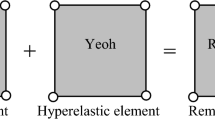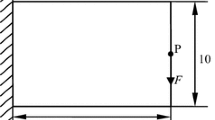Abstract
This paper describes a new computational approach for optimum topology design of 2D continuum structures subjected to design-dependent loading. Both the locations and directions of the loads may change as the structural topology changes. A robust algorithm based on a modified isoline technique is presented that generates the appropriate loading surface which remains on the boundary of potential structural domains during the topology evolution. Issues in connection with tracing the variable loading surface are discussed and treated in the paper. Our study indicates that the influence of the variation of element material density is confined within a small neighbourhood of the element. With this fact in mind, the cost of the calculation of the sensitivities of loads may be reduced remarkably. Minimum compliance is considered as the design problem. There are several models available for such designs. In the present paper, a simple formulation with weighted unit cost constraints based on the expression of potential energy is employed. Compared to the traditional models (i.e., the SIMP model), it provides an alternative way to implement the topology design of continuum structures. Some 2D examples are tested to show the differences between the designs obtained for fixed, design-independent loading, and for variable, design-dependent loading. The general and special features of the optimization with design-dependent loads are shown in the paper, and the validity of the algorithm is verified. An algorithm dealing with 3D design problems is described in Part II, which is developed from the 2D algorithm in the present Part I of the paper.
Similar content being viewed by others
References
Bendsøe, M.P.; Kikuchi, N. 1988: Generating optimal topologies in structural design using a homogenization method. Comput Methods Appl Mech Eng 71(2), 197–224
Bendsøe, M.P. 1989: Optimal shape design as a material distribution problem. Struct Optim 1, 193–202
Bendsøe, M.P.; Guedes, J.M.; Haber, R.B.; Pedersen, P.; Taylor, J.E. 1994: An analytical model to predict optimal material properties in the context of optimal structural design. J Appl Mech 61(4), 930–937
Bendsøe, M.P.; Diaz, A.R.; Lipton, R.; Taylor, J.E. 1995: Optimal design of material properties and material distribution for multiple loading conditions. Int J Numer Methods Eng 38, 1149–1170
Bendsøe, M.P.; Sigmund, O. 1999: Material interpolation schemes in topology optimization. Arch Appl Mech 69, 635–654
Bendsøe, M.P.; Sigmund, O. 2003: Topology Optimization: Theory, Methods and Applications. Berlin, Heidelberg: Springer
Bourdin, B.; Chambolle, A. 2001: Design-dependent loads in topology optimization. Report, Cahiers du CEREMADE No. 01-21, 2001, Université de Paris-Dauphine, France
Burden, R.; Faires, J. 1985: Numerical Analysis. 3rd ed., Boston: Prindle, Weber and Schmidt
Chen, B.; Kikuchi, N. 2001: Topology optimization with design-dependent loads. Finite Elem Anal Des 37, 57–70
Cheng, G.; Olhoff, N. 1982: Regularized formulation for optimal design of axisymmetric plates. Int J Solids Struct 18, 153–169
Cherkaev, A. 2000: Variational Methods for Structural Optimization. Berlin Heidelberg New York: Springer
Du, J. 2001: An approach to computational solution for the optimal design of materials and topology of 2D and 3D continuum structures. In: Proc. WCSMO-4, Fourth World Congress of Structural and Multidisciplinary Optimization (held in Dalian, China, 4–8 June 2001)
Du, J.; Taylor, J.E. 2002: Application of an energy-based model for the optimal design of structural materials and topology. Struct Multidisc Optim 24, 277–292
Du, J.; Olhoff, N. 2004 (in press): Topological optimization of continuum structures with design-dependent surface loading – Part II: algorithm and examples for 3D problems. Struct Multidisc Optim. DOI 10.1007/s00158-004-0380-5
Eschenauer, H.; Olhoff, N. 2001: Topology optimization of continuum structures: A review. Appl Mech Rev 54(4) 331–389
Guedes, J.M.; Taylor, J.E. 1997: On the prediction of material properties and topology for optimal continuum structures. Struct Optim 14, 193–199
Hammer, V.B.; Olhoff, N. 1999: Topology optimization with design dependent loads. In: Proc. WCSMO-3, Third World Congress of Structural and Multidisciplinary Optimization (held in Buffalo, NY, May 17–21, 1999). State University of New York at Buffalo, Buffalo, New York
Hammer, V.B.; Olhoff, N. 2000: Topology optimization of continuum structures subjected to pressure loading. Struct Multidisc Optim 19(2), 85–92
Maute, K.; Ramm, E. 1995: Adaptive topology optimization. Struct Optim 10, 100–112
Olhoff, N.; Rønholt E.; Scheel, J. 1998: Topology optimization of three-dimensional structures using optimum microstructures. Struct Optim 16(1), 001–018
Rodrigues, H; Soto, C.A.; Taylor, J.E. 1999: A design model to predict optimal two-material composite structures. Struct Optim 17, 186–198
Rozvany, G.I.N.; Zhou, M. 1991: Applications of the COC method in layout optimization. In: Eschenauer, H.; Mattheck, C.; Olhoff, N. (eds.), Proc. Int. Conf. on Engineering Optimization in Design Processes (held in Karlsruhe, 1990), pp. 59–70, Berlin Heidelberg New York: Springer
Rozvany, G.I.N.; Zhou, M.; Birker, T. 1992: Generalized shape optimization without homogenization. Struct Optim 4, 250–252
Rozvany, G.I.N.; Bendsøe, M.P.; Kirsch, U. 1995: Layout optimization of structures. Appl Mech Rev 45, 41–119
Rozvany, G.I.N.; Olhoff, N. (eds.), Proc. NATO ARW on Topology Optimization of Structures and Composite Continua (Budapest, 2000), Dordrecht: Kluwer
Sigmund, O. 2000: A 99 line topology optimization code written in matlab. Struct Optim 21(2), 120–127
Taylor, J.E.; Washabaugh, P.D. 1995: A generalized expression of cost for prediction of the optimal material properties tensor. Proc. Summaries, ASME Summer Mechanics Meeting (held at UCLA)
Taylor, J.E. 1998: An energy model for the optimal design of linear continuum structures. Struct Optim 16(2–3), 116–127
Taylor, J.E. 2000: Addendum to: An energy model for the optimal design of linear continuum structures. Struct Multidisc Optim 19(4), 317–320
Author information
Authors and Affiliations
Corresponding author
Rights and permissions
About this article
Cite this article
Du, J., Olhoff , N. Topological optimization of continuum structures with design-dependent surface loading – Part I: new computational approach for 2D problems. Struct Multidisc Optim 27, 151–165 (2004). https://doi.org/10.1007/s00158-004-0379-y
Received:
Revised:
Published:
Issue Date:
DOI: https://doi.org/10.1007/s00158-004-0379-y




